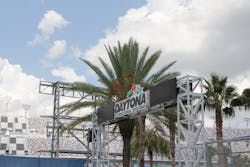Here are a few hypothetical questions to think about: How much money did your department set in budget this year for fuel? How much does a single full gas tank cost? How many vehicles does your department run? How long are your patrol vehicles sitting idle? How much fuel has been burned during that time?
The trick—don't think about a single gas tank. Think about 50 or 100. Think about 3,500. Think about how much of the budget burns away with patrol vehicles idling on the side of the highway. If shaved a tad, think about how much of that burned monies could go to something else like training, new technology, or more officers. The idea here isn't to save a few hundreds, but numbers that need commas—think thousands. Tens of thousands. Think possibly millions.
Derive Systems hosted a recent event at the Daytona International Speedway. A number of first-hand demonstrations were set up to spotlight various benefits of the company's Efficiency engine calibration aftermarket software. Made with the cooperation of major vehicle manufacturers, the programming resembles much like what gear heads used to do with their carburetor and 'set the pins' back when cars actually had carburetors. Have a need for speed? High altitude? Low altitude? With enough know-how you could adjust the carburetor to help your engine run as you wanted—most of the time this was to make their vehicle as efficient as possible for their environment.
Today's vehicles changed that carburetor into an ECU or engine control unit. A programmed hard drive making, let's just say a lot, of decisions every second from each side of the turning of the key (or pushing of the button—that doesn't sound as exciting though). Derive Systems began in 2003 and took the mindset of tweaking the carburetor to the ECU. Essentially re-calibrating optimizing the engine to run as wanted.
The demos
Experiencing Derive Efficiency should start with calibrating the vehicle. Early in the morning, my small group met around an already running Ford F150. A scientific meter was connected and displayed the idle at around 600 RPM, give or take. After literally five button presses (I counted), a 10 to 12 minute install period, and the engine completing it's manufacturer warm-up, this idle RPM dropped to bouncing between 473 to 480.
We were a clever bunch and the group inquired about warranty. The software essentially overrides the manufacturer's programming and that raised plenty of eyebrows. However, our presenter explained that Ford's (for example) warranty was more concerned with going over RPM. And added that, "we're lowering…Ford does not offer a minimum standard." He assured the group that months of testing go into each model's programming. Yet settings, or tuning options, are up to each customer and discussed during the purchasing process. There are some points to help you start on the right foot, so to say. Derive can modify the program to meet the needs of a fleet like police, business, utility, etc.
The company has made its Derive Efficiency software compatible to nearly every major vehicle brand. Unfortunately, it isn't available for FAC, i.e. the Dodge Charger Pursuit, at this time. Nor is it applicable for motorcycles.
With Derive reporting that a typical working vehicle sits in idle roughly 6 hours a day. The company reports a significant amount of savings on the bottom line—a 26% annual fuel savings from the City of Lakeland, Florida last year with "80 law enforcement vehicles and 78 more from the city’s maintenance division." Compare that to Jacksonville County with 3,500 vehicles spending $16 million on fuel alone annually (not making that up, I asked an attending representative from there). It wouldn't be too difficult to see that any fuel efficiency savings could be astronomical.
Now think about our four-legged officers. K9 unit vehicles sit idle reportedly 90% of the time running the air conditioner. I'm unsure whether or not case studies shows K9 unit usage, but one could estimate an assumed significant sum.
Will you have power when you need it?
Attendees included various walks of life. From construction company owners, landscaping companies, major manufacturer reps, to county fleet directors, we all were given the opportunity to get behind the wheel to experience the difference between a non-calibrated vehicle straight from the rental company—to an optimized one.
We were not gentle.
- Payload: 1,000 pounds was set and strapped down in the bed of a F150. Drivers began from a full stop to accelerate as much as they could twice, braking to a full stop halfway between.
- Speed/Pursuit: Two Ford Police Interceptor Utility SUVs and two Chevrolet Tahoes accelerated from a full stop—sans the 1,000 pounds—simulating a rush from idling on the highway, catching up to a vehicle, and coming to a full stop. While it resembled a bit like a drag strip, this wasn't a competition.
- Speed Limiting: Exactly as it sounds. We were asked to take an optimized Tahoe out and accelerate. Derive Efficiency was set for this demo (and probably for our safety) to 45 MPH. As a customer, you have the choice to turn this on and at what speed. My group was gracious enough to let me sit in the passenger seat for photographs, but every driver noticed an uncanny feeling that we should be still accelerating while the SUV…just didn't. While this is more of a comment on the experience of initializing the speed governor software, the trick: RPM. Derive Efficiency allowed the engine to produce only enough power to maintain the max speed, thus saving fuel in wasted energy—saving money.
- Acceleration: Michigan State Police Vehicle Tests and Evaluations would have called this "Dynamic Driving." Two stock Ford Taurus sedans were driven around a short loop with a few chicanes and straight-ways. Drivers experienced the non-calibrated with our own personal "Stig" helping us find the line then drove an optimized Taurus with professional drifter Vaughn Gittin Jr. sitting passenger. Everyone, including yours truly, left this demo with a smile.
The biggest difference between the Efficiency-equipped vehicles vs. non were the gear's shifting points. These automatic vehicles shifted slightly smother, providing power as you progressed to the next gear. For those hauling 2,000 or more pounds, this was a definite interest.
Not being a "car guy", I asked what the Efficiency software was doing to the engine after my turn behind the wheel for the Acceleration demonstration. (There are no photos of this as I entrusted my camera to one of the Derive Systems employee presenters.) My "layman's" / "over-simplification" answer finally made sense. The software sets the shift timing slightly earlier at lower RPMs so when the following gear sets into place there's more horsepower available to follow through.
Suddenly the smooth feeling of hauling 1,000 extra pounds, zooming forward as quickly as possible, and squealing tires every corner made sense.
Having just blasted (and I don't use that term lightly) my way through the short curved course this explanation clicked. I did feel more horsepower powering out of turns. One could only imagine what the Interceptor Ecoboost version would have felt like. If, in fact, I'm correctly understanding this and there is that available power for the engine to get to speed it may provide a level of safety with officers being able to catch-up to suspects on the highway quicker—shortening potential chases.
Ultimately, though, the performance difference between stock and an Efficiency-optimized vehicle was slight. And after all the demonstrations—that's the biggest takeaway.
Your vehicle will work the same—we're not turning it into the Batmobile—yet saving some dollars on the bottom line by adjusting that line labeled "fuel cost."
P.S. I do realize there is—in fact—racing in police work. I'm unaware of any other departments, but the Las Vegas PD have been challenging drag racers for some time. So, technically, there IS…technically.

Jonathan Kozlowski
Jonathan Kozlowski was with Officer.com, Law Enforcement Technology, and Law Enforcement Product News from August 2006 to 2020.
As former Managing Editor for Officer Media Group, he brought a dedicated focus to the production of the print publications and management of the Officer.com online product and company directory. You can connect with Jonathan through LinkedIn.
Jonathan participated as a judge for the 2019 and 2020 FOLIO: Eddie & Ozzie Awards. In 2012, he received an APEX Award of Excellence in the Technology & Science Writing category for his article on unmanned aerial vehicles (UAVs) in police work, aptly titled "No Runway Needed".



